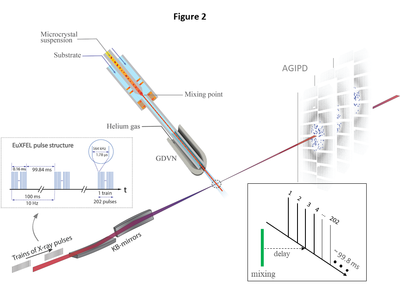Journal:IUCrJ:S2052252521008125
From Proteopedia

Observation of Substrate Diffusion and Ligand Binding in Enzyme Crystals using High Repetition Rate Mix-and-Inject Serial CrystallographySuraj Pandey, George Calvey, Andrea M. Katz, Tek Narsingh Malla, Faisal H. M. Koua, Jose M. Martin-Garcia, Ishwor Poudyal, Jay-How Yang, Mohammad Vakili, Oleksandr Yefanov, Kara A. Zielinski, Saša Bajt, Salah Awel, Katerina Dörner, Matthias Frank, Luca Gelisio, Rebecca Jernigan, Henry Kirkwood, Marco Kloos, Jayanath Koliyadu, Valerio Mariani, Mitchell D. Miller, Grant Mills, Garrett Nelson, Jose L. Olmos Jr., Alireza Sadri, Tokushi Sato, Alexandra Tolstikova, Weijun Xu, Abbas Ourmazd, John H. C. Spence, Peter Schwander, Anton Barty, Henry N. Chapman, Petra Fromme, Adrian P. Mancuso, George N. Phillips Jr., Richard Bean, Lois Pollack, Marius Schmidt [1] Molecular Tour  Figure 2. Experimental setup at the European XFEL. BlaC microcrystals are mixed with substrate and injected into the X-ray interaction region (dotted circle) after a delay determined by the distance between the mixing region and the X-rays, the capillary width, and the flow rate. Diffusion of substrate into the crystals occurs during this time. The mixture is probed by trains of X-ray pulses. The trains repeat 10 times per second. Pulses within the trains repeat with 564 kHz, hence the pulses are spaced by 1.78 μs. 202 pulses were in each train for this experiment. The AGIPD collects the diffraction patterns and reads them out for further analysis. Inset, data collection: With a once selected injector geometry and flow rate, the delay is fixed by the distance of the mixing region from the X-ray interaction region. All pulses in all trains (here pulse #3) probe the same time delay. The EuXFEL pulse structure is most efficiently used. We follow the increase of the CEF occupancy in the catalytic cleft of BlaC from 5 ms to 50 ms after mixing with CEF by XFEL based MISC experiments. At the edge of the crystal, almost all active BlaC subunits (B and D) are bound to CEF already at 5 ms. In the center the BlaC-CEF complex concentration is 0.21 mmol/L (2.7 % of the total concentration of B and D subunits in the crystal), although the CEF concentration delivered by diffusion is already 35 mmol/L (which is 23 % of the outside CEF concentration but 5.5 times the stoichiometric concentration). The situation changes completely at 30 ms, where almost 100 % occupancy is reached everywhere in the crystal which is in accordance with earlier results (Olmos et al., 2018)[2], and with the occupancy at Δtm = 50 ms reported here (see movie below) Steps of the CEF-BlaC binding:
See also the movie below, which visualizes how the CEF interacts with the BlaC: From the increasing occupancy values we are able to estimate an effective diffusion coefficient Deff of CEF in the BlaC microcrystals. Diffusion is roughly an order of magnitude slower in the crystals than that in water. By using the Deff we are now able to calculate CEF occupancies anywhere in the microcrystals and at any time. Since the BlaC-CEF complex formation triggers the enzymatic cycle, the speed of its formation determines the time-resolution of the MISC method. Our results show that the time-resolution is on the order of 5 ms for our microcrystals. The structures of any intermediates whose lifetimes are longer can therefore be characterized. Once faster intermediates are concerned, smaller crystals must be used that support a faster buildup of the enzyme substrate complex. In addition to the CEF binding we observe the reaction of BlaC with an inhibitor sulbactam (SUB) at 66 ms. SUB reacts to a so-called trans-enamine in subunits B and D of the BlaC already after 66 ms. However, SUB stays intact in subunits A and C. As the reaction proceeds to the trans-enamine also in A and C, the structures of the weakly bound SUBs in these subunits at 66 ms represent an interesting intermediate that would not have been detected in static structures. PDB references: BlaC, unmixed, 7k8l; mixed with ceftriaxone, 5 ms, 7k8e; 10 ms, 7k8f; 50 ms, 7k8h; mixed with sulbactam, 66 ms, 7k8k. References
|
| ||||||||||

